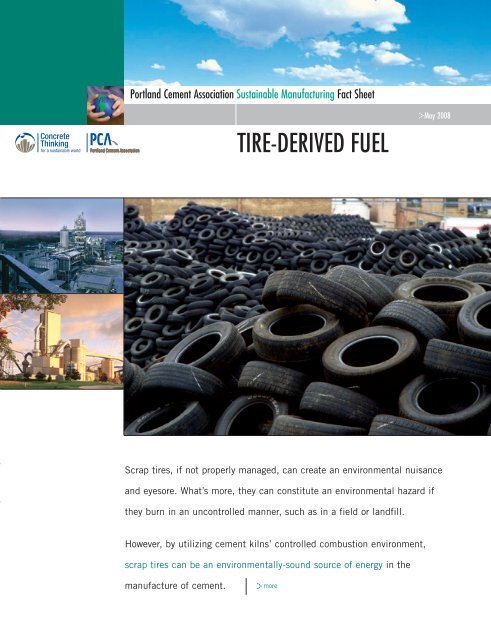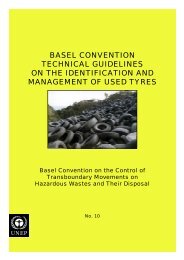Tire-Derived Fuel - Innovative Fuel
Tire-Derived Fuel - Innovative Fuel
Tire-Derived Fuel - Innovative Fuel
Create successful ePaper yourself
Turn your PDF publications into a flip-book with our unique Google optimized e-Paper software.
ICAL CONFIGURATIONZONTAL CONFIGURATIONPortland Cement Association Sustainable Manufacturing Fact SheetTIRE-DERIVED FUELMay 2008Scrap tires, if not properly managed, can create an environmental nuisanceand eyesore. What’s more, they can constitute an environmental hazard ifthey burn in an uncontrolled manner, such as in a field or landfill.However, by utilizing cement kilns’ controlled combustion environment,scrap tires can be an environmentally-sound source of energy in themanufacture of cement.more
Portland Cement Association Sustainable Manufacturing Fact SheetTIRE-DERIVED FUELcontinuedThe Cement-Making ProcessPortland cement manufacturing isa four-step process:1. Raw materials, including limestoneand small amounts of sand andclay, come from quarries usuallylocated near the cement manufacturingplant. Limestone is typicallyabout 80% of the raw mix and isthe source of calcium. The remainingraw materials provide the silicaand the necessary small amountsof alumina and iron.2. The materials are carefullyanalyzed, precisely combinedand blended, and then groundfor further processing.3. The ground materials are heated inan industrial furnace, called a kiln;kilns are a rotating vessel rangingin length from 60 to over 200meters (200 to >650 feet) longwith a diameter ranging from 3 to7.5 meters (10 to 25 feet). Thekiln reaches temperatures of1,450° C (2,650° F). The heatcauses the materials to turn into anew marble-sized substance calledclinker. The kiln flame is fueled bypowdered coal, powdered petroleumcoke, natural gas, oil, and/orrecycled materials burned forenergy recovery.4. Red-hot clinker is cooled andground with a small amount ofgypsum. The end-result is a finepowder called portland cement. Ateach stage, process data are continuouslymonitored to produce ahigh-quality product, improve energyefficiency, and minimizeemissions.Cement or Concrete?The terms cement and concrete areoften misused. Cement is an ingredientof concrete. It is the fine powder that,when mixed with water, sand, and gravelor crushed stone, forms the rock-likemass known as concrete. Cement actsas the binding agent or glue inconcrete.Like fossil fuels such as coal, oil, and natural gas, tires contain hydrocarbons. Pound for pound,tires have more fuel value than coal. Hundreds of millions of used tires are generated annuallyin the United States. By simply disposing of these tires, we miss an important recycling opportunity:the chance to recover their energy and conserve our resources of fossil fuels.Cement making is an ideal process for recovering this energy. The intense heat of the kilnensures complete destruction of the tires. There is no smoke or visible emissions from the tires.In fact, the use of tires as fuel can actually reduce certain emissions.An Alternative to Traditional Fossil <strong>Fuel</strong>sThe Rubber Manufacturers Association (RMA) has estimated that 58 million scrap tires wereused as fuel in portland cement plants in 2005 out of the 299 million tires produced that year[RMA 2006]. The United States Environmental Protection Agency (USEPA) states that tirederivedfuel (TDF) contains about the same amount of energy as oil and 25% more energy thancoal [USEPA 2007b]. This means that each ton of TDF used by a portland cement plant hasthe potential to replace 1.25 tons of coal, and the impacts of coal mining, processing, andtransporting are avoided. In energy terms, the cement industry consumed 12.6 trillion BTUs ofTDF in 2006 which is approximately 3.6% of all of the non-electrical energy required by themanufacturing process [PCA 2007a].TDF Use Is IncreasingThe number of cementplants utilizing scraptires as a supplementalfuel has risen dramaticallyover the last 19years. Figure 1 showsthe increase in portlandcement plants utilizingTDF [PCA 1995, 2002,and 2007a]. As of2006, state and localenvironmental agencieshave approved the useof TDF at 48 plants in21 states (Table 1).TABLE 1FIGURE 1U.S. Portland Cement Plants Utilizing <strong>Tire</strong>-<strong>Derived</strong> <strong>Fuel</strong> [PCA 1995, 2002, and 2007a]88 89 90 91 92 93 94 95 96 97 98 99 00 01 02 03 04 05 06Summary of 48 Portland Cement Manufacturing Plants Currently Permitted and Utilizing <strong>Tire</strong>-<strong>Derived</strong> <strong>Fuel</strong>s[PCA 2007b and RMA 2006]Ash Grove Cement Co.Chanute, KSDurkee, ORForeman, ARInkom, IDMidlothian, TXNephi, UTSeattle, WABuzzi Unicem USA, Inc.Cape Girardeau, MOOglesby, ILPryor, OKSweetwater, TXCalifornia Portland Cement Co.Colton, CACapitol Aggregates, Inc.San Antonio, TXNUMBER OF PLANTS5550454035302520151050CEMEXBrooksville, FL (South)Brooksville, FL (North)Clinchfield, GADemopolis, ALKnoxville, TNNew Braunfels, TXOdessa, TXVictorville, CAESSROC Cement Corp.Bessemer, PAFrederick, MDFlorida Rock Industries, Inc.Newberry, FLYEARHolcim (US) Inc.Ada, OKClarksville, MODundee, MIFlorence, COHagerstown, MDMason City, IAMidlothian, TXMorgan, UTTheodore, ALLafarge North America Inc.Calera, ALGrand Chain, ILHarleyville, SCTulsa, OKWhitehall, PALehigh Cement CompanyFleetwood, PALeeds, ALRedding, CAMitsubishi Cement Corp.Lucerne Valley, CA55504540353025201510Monarch Cement CompanyHumboldt, KSNational Cement CompanyLebec, CARagland, ALTexas Industries, Inc.New Braunfels, TXOro Grande, CATexas-Lehigh Cement CompanyBuda, TX50
Additional U.S. plants have expressed interest in obtaining a permit or have received a permit buthave not begun utilizing scrap tires as a fuel. The delay in utilizing TDF may be due to equipmentlimitations at the cement plant, regional TDF availability, state regulatory agency review, and localcommunity discussions. Figure 2 shows the locations of all of the facilities currently utilizing in TDF.Beneficial EffectsThe environmental benefits of utilizing scrap tires as a supplemental fuel in the portland cementmanufacturing process are multifold. When whole tires are combusted in cement kilns, the steelbelting becomes a component of the clinker, replacing some or all of the iron required by themanufacturing process.In 2008, PCA member companies completed a study on the impact of TDF firing on cement kilnair emissions. The study’s data set included emission tests from 31 of the cement plants presentlyfiring TDF. Dioxin-furan emission test results indicated that kilns firing TDF had emissions approximatelyone-third of those kilns firing conventional fuels – this difference was statistically significant.Emissions of particulate matter (PM) from TDF-firing kilns were 35% less than the levels reportedfor kilns firing conventional fuels (not statistically significant due to the low PM emissions reportedfor essentially all cement plants). Nitrogen oxides, most metals, and sulfur dioxide emissions fromTDF-firing kilns also exhibited lower levels than those from conventional fuel kilns. The emissionvalues for carbon monoxide and total hydrocarbons were slightly higher in TDF versus non-TDFfiring kilns.However, none of the differences in the emission data sets between TDF versus non-TDF firingkilns for sulfur dioxide, nitrogen oxides, total hydrocarbons, carbon monoxide, and metals werestatistically significant. Separate studies conducted by governmental agencies and engineeringconsulting firms have also indicated that TDF firing either reduces or does not significantly affectemissions of various contaminants from cement kilns [PCA 2008].moreMid-Kiln Injection of Scrap <strong>Tire</strong>sWith every revolution of their kiln,the Ash Grove Cement Companyplant in Midlothian, TX injectsone or two scrap tires througha special port. This automatedsystem allows the plant toutilize whole tires to replaceup to 25% of the traditionalfossil fuels required by themanufacturing process.<strong>Tire</strong> handling system at aportland cement plantFIGURE 2U.S. Portland Cement Plants Currently Utilizing <strong>Tire</strong>-<strong>Derived</strong> <strong>Fuel</strong>WAMEAt the Capital Aggregates cementplant in San Antonio, TX, scraptires are received and stored insemi trailers. These trailers arehydraulically lifted to allow thetires to roll into a singulator whichextracts one tire at a time andplaces it on the conveyor system.The automated conveyor transportsthe scrap tires to the injectionpoint in the kiln system.MTNDVTNHCAORNVIDUTWYCOSDNEKSMNIAMOWIILMIINKYOHWVNYPAMDVANJDEMACTNCTNAZNMOKARSCNote: No cement plantsin Alaska and HawaiiTXPortland cement plants currently permitted and utilizing tire-derived fuels (48 plants)LAMSALGAFLFOR ADDITIONAL INFORMATION REGARDINGTHIS SUBJECT, PLEASE CONTACT:Tyrone Wilson, Ph.D.Portland Cement Association500 New Jersey Avenue, N.W. 7th FloorWashington, DC 20001Voice: 202.408.9494Fax: 202.408.0877Email: twilson@cement.org
VERPortland Cement Association Sustainable Manufacturing Fact SheetTIRE-DERIVED FUELcontinuedUnder their program for the voluntary reporting of greenhouse gases, the United States Department of Energy(USDOE) has estimated that the combustion of TDF produces less carbon dioxide (CO 2 ) per unit of energy thancoal [USDOE 2007a]. This means that when TDF replaces coal in a portland cement kiln—for example, whenscrap tires are used to heat the precalciner vessel instead of coal—less CO 2 will be produced. The Mojave DesertAir Quality Management District in California has determined that TDF use is NOx RACT (“Reasonably AvailableControl Technology”) for portland cement kilns [CARB, 2002].HORThe use of TDF is common in other parts of the world. In Japan, there were 103 million scrap tires generated in2006 with 16% being used as a fuel in the cement industry. For that year Japan recycled 54% of all scrap tiresthrough heat utilization [JATMA 2007]. Of the approximately 3.2 million metric tons of scrap tires handled annuallyin Europe, 31.6% are directed to energy recovery systems including portland cement kilns [ETRMA 2007].ReferencesAir Emissions Data Summary for Portland Cement Pyroprocessing Operations Firing <strong>Tire</strong>-<strong>Derived</strong> <strong>Fuel</strong>s, PCA R&D Serial No.3050, John Richards; David Goshaw; Danny Speer, and Tom Holder, Portland Cement Association, Skokie, IL, USA, 2008.End of Life Tyres Management in Europe, European Tyre and Rubber Manufacturers’ Association, Brussels, Belgium, July 2007.http://www.etrma.org/public/activitieseoflttrenf.aspInstructions for Form EIA-1605, Voluntary Reporting of Greenhouse Gases, Energy Information Administration, United StatesDepartment of Energy, Washington, DC, USA, October 2007a.Management of Scrap <strong>Tire</strong>s – <strong>Tire</strong>d <strong>Derived</strong> <strong>Fuel</strong>, United States Environmental Protection Agency, Washington, DC, USA,September 7, 2007b. http://www.epa.gov/epaoswer/non-hw/muncpl/tires/tdf.htm“Rule 1161 – Portland Cement Kilns,” (Adopted: 06/28/95; Amended: 10/22/01; Amended: 03/25/02), Mojave Desert AirQuality Management District, California Air Resources Board, Sacramento, CA, USA, 2002. http://www.arb.ca.gov/drdb/moj/curhtml/r1161.pdfTyre Industry of Japan 2007, Japan Automobile Tyre Manufacturers Association, Inc., Tokyo, Japan, July 2007.U.S. and Canadian 1994 Labor-Energy Input Survey, Portland Cement Association, Skokie, IL, USA, December 1995.VERTICAL CONFIGURATIONU.S. and Canadian 2000 Labor-Energy Input Survey, Portland Cement Association, Skokie, IL, USA, March 2002.U.S. and Canadian 2006 Labor-Energy Input Survey, Portland Cement Association, Skokie, IL, USA, 2007a.U.S. and Canadian Portland Cement Industry: Plant Information Summary, December 31, 2006, Portland Cement Association,Skokie, IL, USA, 2007b.U.S. Scrap <strong>Tire</strong> Markets 2005 Edition, Rubber Manufacturers Association, Washington, DC, USA, November 2006.HORIZONTAL CONFIGURATIONPortland Cement Association is a trade association representing cement companies in the United States andCanada. PCA’s U.S. membership consists of 30 companies operating 115 plants in 36 states. PCA membersaccount for more than 98 percent of cement-making capacity in the United States and 100 percent in Canada.Portland Cement Association5420 Old Orchard RoadSkokie, Illinois 60077-1083847.966.6200 Fax 847.966.9781500 New Jersey Avenue, N.W. 7th FloorWashington, DC 20001202.408.9494 Fax 202.408.0877PRINTED ON RECYCLED PAPERwww.cement.org© Portland Cement Association. All rights reserved. IS325.02



